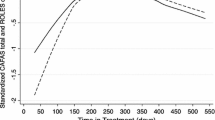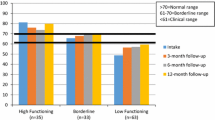Abstract
Although females represent almost half of all youth involved in residential care in the US, very little is known about this population. In order to examine differences in characteristics of male (n = 308) and female (n = 180) youth departing from residential care, data were collected on 488 youth from a large residential treatment facility in the Midwest. Gender differences were assessed on 16 variables measured at the time of departure across family, education, behavior, and departure domains. Overall, male and female youth departing from residential care were very similar for measures collected at the time of departure. Only three variables (GPA at departure, number of school referrals during the previous 8 weeks, and planned departure) were found to be significantly different between males and females. Implications for future research and the provision of aftercare services are discussed.
Similar content being viewed by others
References
Asarnow, J. R., Aoki, W., & Elson, S. (1996). Children in residential treatment: A follow-up study. Journal of Clinical Child Psychology, 25, 209–214.
Achenbach, T. M., & Rescorla, L. A. (2001). Manual for ASEBA school-age forms & profiles. Burlington, VT: University of Vermont, Research Center for Children, Youth, & Families.
Baker, A. J. L., Archer, M., & Curtis, P. A. (2005). Age and gender differences in emotional and behavioural problems during the transition to residential treatment: The Odyssey Project. International Journal of Social Welfare, 14, 184–194.
Curry, J. F. (2004). Future directions in residential treatment outcome research. Child and Adolescent Psychiatric Clinics of North America, 13, 429–440.
Child Welfare League of America (2005). Retrieved December 13, 2006 from http://www.cwla/programs/fostercare/factsheet.htm
Connor, D. F., Doerfler, L. A., Toscano, P. F., Volungis, A. M., & Steingard, R. J. (2004). Characteristics of children and adolescents admitted to a residential treatment center. Journal of Child and Family Studies, 13, 497–510.
Gagnon, J. C., & Leone, P. E. (2006). Elementary day and residential schools for children with emotional and behavioral disorders: Characteristics of educators and students. Education & Treatment of Children, 29, 51–78.
Handwerk, M. L., Clopton, K., Huefner, J. C., Smith, G. L., Hoff, K. E., & Lucas, C. P. (2006). Gender differences in adolescents in residential treatment. American Journal of Orthopsychiatry, 76, 312–324.
Hawkins, R. P., Almeida, M. C., Fabry, B., & Reitz, A. L. (1992). A scale to measure restrictiveness of living environments for troubled children and youths. Hospital & Community Psychiatry, 43, 54–58.
Hodges, K., Doucette-Gates, A., & Kim, C. (2000). Predicting service utilization with the child and adolescent functional assessment scale in a sample of youths with serious emotional disturbance served by Center for Mental Health Services-funded demonstrations. The Journal of Behavioral Health Services & Research, 27, 47–59.
Hodges, V. G., Guterman, N. B., Blythe, B. J., & Bronson, D. E. (1989). Intensive aftercare services for children. Social Casework, 70, 397–404.
Hoffart, I., & Grinnell, R. M. (1994). Behavioral differences of children in institutional and group home care. Community Alternatives: International Journal of Family Care, 6, 33–47.
Hornick, J. P., Phillips, D. M., & Kerr, N. (1989). Gender differences in behavioral problems of foster children: Implications for special foster care. Community Alternatives: International Journal of Family Care, 1, 35–52.
Hoagwood, K., & Cunningham, M. (1992). Outcomes of children with emotional disturbance in residential treatment for educational purposes. Journal of Child and Family Studies, 1, 129–140.
Hussey, D. L., & Guo, S. (2002). Profile characteristics and behavioral change trajectories of young residential children. Journal of Child and Family Studies, 11, 401–410.
Larzelere, R. E., Daly, D. L., Davis, J. L., Chmelka, M. B., & Handwerk, M. L. (2004). Outcome evaluation of girls and boys town’s family home program. Education & Treatment of Children, 27, 130–149.
Leichtman, M., & Leichtman, M. L. (2002). Facilitating the transition from residential treatment into the community: IV. Making use of community resources. Residential Treatment for Children & Youth, 19, 43–52.
Lieberman, R. E. (2004). Future directions in residential treatment. Child and Adolescent Psychiatric Clinics of North America, 13, 279–294.
Mendes, P., & Moslehuddin, B. (2006). From dependence to interdependence: Towards better outcomes for young people leaving state care. Child Abuse Review, 15, 110–126.
O’Malley, F. (1993). Short-term residential treatment of disturbed adolescents in a continuum of care. Children and Youth Services Review, 15, 245–260.
Trout, A. L., Chmelka, M. B., Thompson, R. W., Epstein, M. H., Tyler, P., & Pick, R. (in press). The departure status of youth from residential group care: Implications for aftercare. Journal of Child and Family Studies.
Vincent, J., Kramer, J. J., Shriver, M., & Spies, R. (1995). Direct comparisons between residential and community students on school performance measures in a public school setting. Behavioral Interventions, 10, 69–77.
Weis, R., Whitemarsh, S. M., & Wilson, N. L. (2005). Military-style residential treatment for disruptive adolescents: effective for some girls, all girls, when, and why? Psychological Services, 2, 105–122.
Wells, K. (1991). Placement of emotionally disturbed children in residential treatment: A review of placement criteria. American Journal of Orthopsychiatry, 61, 339–347.
Young, I. L. (1977). Differences between male and female adolescents in residential treatment. Journal of Consulting and Clinical Psychology, 45, 953.
Author information
Authors and Affiliations
Corresponding author
Rights and permissions
About this article
Cite this article
Griffith, A.K., Trout, A.L., Chmelka, M.B. et al. Youth Departing from Residential Care: A Gender Comparison. J Child Fam Stud 18, 31–38 (2009). https://doi.org/10.1007/s10826-008-9204-3
Received:
Accepted:
Published:
Issue Date:
DOI: https://doi.org/10.1007/s10826-008-9204-3




